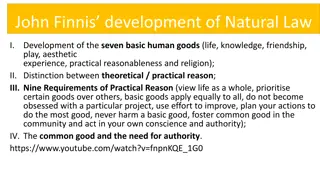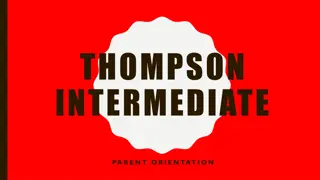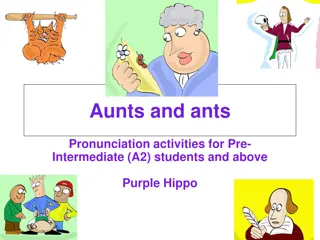
Effective Strategies for Preventing Violence in Health Care Settings
Learn how to identify and prevent violent incidents in health care through professionalism, preparation, and appropriate responses. Understand the risks involved and the importance of teamwork and proper intervention techniques.
Download Presentation

Please find below an Image/Link to download the presentation.
The content on the website is provided AS IS for your information and personal use only. It may not be sold, licensed, or shared on other websites without obtaining consent from the author. If you encounter any issues during the download, it is possible that the publisher has removed the file from their server.
You are allowed to download the files provided on this website for personal or commercial use, subject to the condition that they are used lawfully. All files are the property of their respective owners.
The content on the website is provided AS IS for your information and personal use only. It may not be sold, licensed, or shared on other websites without obtaining consent from the author.
E N D
Presentation Transcript
Housekeeping Details Picture 4 Picture 2
Course Objectives 1. Understand that violence happens in Health Care. 2. We can do things to help prevent these incidents through Professionalism and Preparation. 3. Learn to Identify various factors as to why the violent behaviour is occurring. 4. Learn appropriate responses to the Respondent and Operant behaviour. 5. Review the basic aspects of Recording a violent incident.
Staff members who have developed a systematic approach to the treatment of assaultive behavior are less likely to injure or be injured during an assaultive incident than those who haven t.
Description of Terms Approach principles not specific interventions. Problem-solving asking the right questions Emergency response primary plan, then secondary, then PART. Gender neutral don t need to be strong or male to use PART. Teamwork no heroes please . Rights Client and worker, both kept safe. Acceptance has been accepted in many places for years.
PART Interventions Used when: the primary treatment plan doesn t work; the primary back up plan doesn t work; you are facing an immediate threat of injury. It is important that you stick to the primary plan for each individual.
Course Background As agencies assume responsibility for the treatment of people with assaultive behavior, they face a clear pattern of risks.
What are the risks? That the individual will be successful in injuring themselves or others That the staff could be seriously injured during the incident Staff members could contribute to the injury Lack of teamwork could contribute to the injury Managers could contribute to the injury Public censure Formal penalties from court or legislation
Disclaimer The techniques taught in the PART workshop have proven safe and effective. Their proper application is the responsibility of all staff involved. Instruction cannot be a substitute for professional judgment.
Course Outline Purpose What would we like to see as outcome? Professionalism Why do I do what I do? Preparation How have I prepared myself for this job/today? Identification Can I identify why it s happening? Response Can we approach appropriately? Recording/Reporting How do I share this? Follow-up/plan Can we work together to not have it reoccur?
Purpose Understanding of treatment plan outcomes. What do we want to have happen? If you know what s supposed to happen, you know how to help. If there is no plan, PART, working in crisis mode, may become the primary plan not it s intent.
Professionalism Self as a tool Professionalism and safety Do we pose a threat to ourselves and others? Features of professionalism Mood What causes your moods? Attitude Cynicism, pessimism, others. Motivation What brought me to this job and what keeps me here.
Professionalism Taking responsibility for the disciplined management of mood, attitude and motivation in the service of the client.
Preparation Attire right clothes for the job. Mobility ready to move. Observation Do I sense everything? Self-control Don t lose your cool. self-assessment know your limits regaining self-control restoration and healing What are things that make you lose self control?
Self-control Self-assessment Know your limits Regaining self-control Restoration and healing What are things that make you lose self control?
What Do I Bring? Our attitude (and prejudices) Our self-control (or not) Our mobility (or not) Our observation (or not) Our past experiences (whatever they may be)
Identification Legal Model Stress Model Developmental Model Communication Model Interactive Model Environmental Model Socio-cultural Model Common knowledge Model
Legal Model common assault assault causing bodily harm aggravated assault This is not intended as legal advice
Stress Model Assault cycle I. Triggering self control II. Escalation crisis intervention III. Crisis crisis intervention IV. De-escalation self control V. Post-Crisis Depression unconditional positive regard
Developmental Model preschool age children early elementary age children late elementary age children early adolescents late adolescents young adults middle aged adults elderly
Communication Model Withdrawal Passivity Assertion Aggression Assault
Environmental Model physical conditions staff performance problems scheduling problems
Socio-cultural Model Aggression is a result of: social training Examples? social settings Gangs, fight clubs, etc.
Common Knowledge Model Fear Frustration Manipulation Intimidation
Respondent Behavior Fear Frustration
Operant Behavior Manipulation Intimidation
Fear - Respondent Motive: irrational need to escape, defend against or eliminate a perceived threat. Signs of impending aggression: visual auditory history
Visual Signals Posture tense, prepared to defend, hide or run Skin Colour pale or ashen (depending upon natural skin tone) Facial Expression wide-eyed or fearful
Auditory Signals Voice quality whining, pleading Breathing rapid, shallow, irregular
Confirming History Withdrawal and victimization Aggressive outbursts
Crisis Intervention for Fear Goal: threat reduction Posture relaxed, open, hands in full view Gestures slow, palms up Position off to one side, 8-10 feet away Voice quality firm, reassuring, confident Speech content logical, encouraging calm reflection, promise to help if possible Eye contact if sought but do not force Physical contact light, if any
Frustration Respondent Motive: irrational need to express frustration in a physically destructive manner Signs of Impending Aggression: visual auditory history
Visual Signals Posture tense and prepared to assault Skin Colour tones of purple, red or red blotches (depending upon natural skin tone) Facial Expression tense, focused and angry
Auditory Signals Voice quality menacing, aggressive, loud Breathing loud, deep, long and heavy
Confirming History Low frustration tolerance coupled with impulsiveness
Crisis Intervention for Frustration Goal: Control Posture self-confident, commanding, firm, in control Gestures firm, commanding, palms out or down Position directly in front but out of striking range Voice quality quiet, firm, commanding but use a low tone Speech content repetitive, confident commands without threat Eye contact direct and expressive Physical contact firm, without excessive movement or pain
Manipulation - Operant Motive: impulsive attempt to obtain something in exchange for not losing emotional control and doing something dangerous Signs of Impending Aggression: visual auditory history
Visual difficult to interpret
Auditory Signals whiny voice with gimmie words of poor me (pitiable) victim accusations, comparisons and trivia in more aggressive tones threats and actions against property assault is attempted
Confirming History losing control assaulting physically when feeling deprived or oppressed
Crisis Intervention for Manipulation Goal: detachment Posture closed, relaxed Gestures disapproval and mild irritation Position 4-5 feet away, close enough to intervene but far enough away to show non-involvement Voice quality detached, mechanical, slightly bored Speech content quiet, repetitive, broken record Eye contact avoid look at forehead or chin Physical contact quick and unemotional make contact with clothing, not skin
Intimidation Motive: calculated attempt to obtain something in exchange for physical safety or freedom from threat of injury Signs of Impending Aggression: visual auditory history
Visual basically neutral or unremarkable threatening posture
Auditory Signals menacing voice quality and threatening words recognizable pattern: clear, strong demands believable threat refusal to comply followed by attempt to injure through assault
Confirming History bullying extortion other criminal assault
Crisis Intervention for Intimidation Goal: clear consequences of action(s) Posture poised and ready to move Gestures few and far between Position greatest relative defensive advantage Voice quality matter of fact, monotone, emotionless; avoid screaming, shouting or threatening Speech content clear and direct statement of consequences Eye contact sparingly to emphasize a statement Physical contact if necessary, quick and smooth and as matter of fact as possible
Identification - summary assaultive incidents can be categorized into levels of dangerousness incidents progress through a 5-phase cycle assaultive incidents are signaled by, and grow from patterns of unbalanced, and assertive communication function of developmental age
Identification - summary environmental irritants often contribute a perceived threat to deprive a person of basic needs may lead to assault often related to social or cultural pressures assaultive incidents develop from patterns of behaviour
Response Crisis Intervention Reacting appropriately to the phase of the violent incident. Rule of five Evasion Getting our of the way Restraint Holding a person in place Less Aggressive Most Aggressive






















